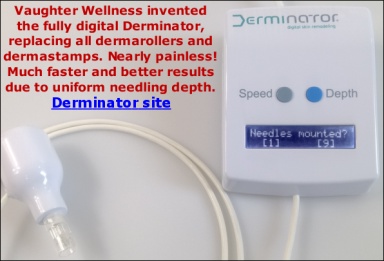Kelo-cote is a silicone-based cream used in prevention or improvement of hypertrophic or keloid scars. The mechanism of action is not completely understood. Several studies findings suggest it is not the silicone itself that has an effect but it is the occlusion and hydration that forms under the silicone sheets which is effective in improving hypertrophic and keloid scars.
Treatment of scars and keloids with a cream containing silicone oil Abstract
The clinical effect of silicone cream containing 20% of silicone oil was tested on 47 patients with hypertrophic scars and keloids.
A silicone cream/occlusive dressing technique, quite similar in manner to silicone gel treatment, resulted in a remarkable improvement of scars and keloids in 9 of 11 cases (82%) whereas the simple application of the cream onto the scars and keloids of 36 cases resulted in only mild improvement in 8 (22%).
Using the chi-square test, a statistically significant difference was seen between these two treatments (p < 0.01).
From these findings, we suggest that occlusion and hydration are the principal modes of action of the silicone gel sheet method and our silicone cream/occlusive dressing technique.
https://http://www.ncbi.nlm.nih.gov/pubmed/2104531 Cytokine mRNA changes during the treatment of hypertrophic scars with silicone and nonsilicone gel dressings. OBJECTIVE.
To determine whether silicone is an essential factor in the treatment of hypertrophic scars and investigate the effects of occlusive dressing therapy on the expression of key wound healing mediators.
CONCLUSIONS.
This study demonstrates that silicone is not a necessary component of occlusive dressings in the treatment of hypertrophic scars. The pathogenesis of hypertrophic scars is further elucidated by demonstrating that there is molecular evidence for extensive connective tissue remodeling occurring during occlusive dressing therapy.
https://http://cat.inist.fr/?aModele=afficheN&cpsidt=2614927 Hydration and occlusion treatment for hypertrophic scars and keloids. Sawada Y, Sone K.
Department of Plastic and Reconstructive Surgery, Hirosaki University School of Medicine, Japan.
Abstract
In 31 patients with hypertrophic scars or keloids, a side by side test was carried out to check the efficacy of an occlusive dressing technique using cream which did not contain silicone oil, versus a simple application of vaseline, used as a control. In all cases, the cream treated areas of scar and keloid demonstrated a remarkable improvement over that of the vaseline treated area. These findings strongly suggest that the mechanisms of hydration and occlusion are the main basis of the therapeutic action of this method in treating hypertrophic scars and keloids.
https://http://www.ncbi.nlm.nih.gov/pubmed/1493533BTW, Infadolan ointment that we sell for dermarolling aftercare is a semi-occlusive ointment that prevents water evaporation from the skin and thus keeps it extra moisturized (just like silicone). Adding "water creams" or glycerin to the skin does not moisturize it for more than several minutes. Topically added water actually increases the evaporation of water from the skin. The skin contains enough water. The top layer of the skin works as a barrier that prevents evaporation from the skin. If this barrier doesn't work properly or is temporarily compromised, the skin becomes dry. Adding water does not solve it. Establishing a barrier that prevents water evaporation solves it. That is why oils are much better moisturizers than any light moisturizing cream because oils form a film on the skin that prevents the evaporation of water. The film however can be a problem with acne prone skin.
You can wrap your scar into food wrap to enhance the occlusive effects of Infadolan or other products.





